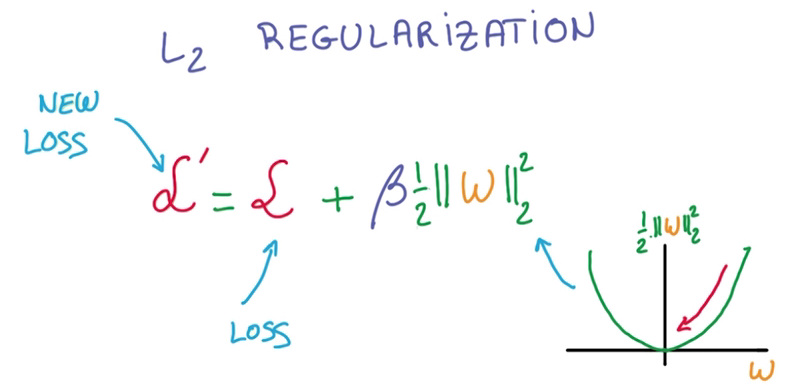Google深度学习笔记 TensorFlow实现与优化深度神经网络
全连接神经网络
辅助阅读:TensorFlow中文社区教程 - 英文官方教程代码见:full_connect.py
Linear Model
- 加载lesson 1中的数据集
- 将Data降维成一维,将label映射为one-hot encoding
def reformat(dataset, labels): dataset = dataset.reshape((-1, image_size * image_size)).astype(np.float32) # Map 0 to [1.0, 0.0, 0.0 ...], 1 to [0.0, 1.0, 0.0 ...] labels = (np.arange(num_labels) == labels[:, None]).astype(np.float32) return dataset, labelsTensorFlow Graph
- 使用梯度计算train_loss,用tf.Graph()创建一个计算单元
- 用tf.constant将dataset和label转为tensorflow可用的训练格式(训练中不可修改)
- 用tf.truncated_normal生成正太分布的数据,作为W的初始值,初始化b为可变的0矩阵
- 用tf.variable将上面的矩阵转为tensorflow可用的训练格式(训练中可以修改)
- 用tf.matmul实现矩阵相乘,计算WX+b,这里实际上logit只是一个变量,而非结果
- 用tf.nn.softmax_cross_entropy_with_logits计算WX+b的结果相较于原来的label的train_loss,并求均值
- 使用梯度找到最小train_loss
python optimizer = tf.train.GradientDescentOptimizer(0.5).minimize(loss) - 计算相对valid_dataset和test_dataset对应的label的train_loss
上面这些变量都是一种Tensor的概念,它们是一个个的计算单元,我们在Graph中设置了这些计算单元,规定了它们的组合方式,就好像把一个个门电路串起来那样
TensorFLow Session
Session用来执行Graph里规定的计算,就好像给一个个门电路通上电,我们在Session里,给计算单元冲上数据,That’s Flow.- 重复计算单元反复训练800次,提高其准确度
- 为了快速查看训练效果,每轮训练只给10000个训练数据(subset),恩,每次都是相同的训练数据
- 将计算单元graph传给session
- 初始化参数
- 传给session优化器 - train_loss的梯度optimizer,训练损失 - train_loss,每次的预测结果,循环执行训练
python with tf.Session(graph=graph) as session: tf.initialize_all_variables().run() for step in range(num_steps): _, l, predictions = session.run([optimizer, loss, train_prediction]) - 在循环过程中,W和b会保留,并不断得到修正
- 在每100次循环后,会用验证集进行验证一次,验证也同时修正了一部分参数
python valid_prediction.eval() - 最后用测试集进行测试
- 注意如果lesson 1中没有对数据进行乱序化,可能训练集预测准确度很高,验证集和测试集准确度会很低
这样训练的准确度为83.2%
SGD
- 每次只取一小部分数据做训练,计算loss时,也只取一小部分数据计算loss
- 对应到程序中,即修改计算单元中的训练数据,
- 每次输入的训练数据只有128个,随机取起点,取连续128个数据:
python offset = (step * batch_size) % (train_labels.shape[0] - batch_size) batch_data = train_dataset[offset:(offset + batch_size), :] batch_labels = train_labels[offset:(offset + batch_size), :]
- 每次输入的训练数据只有128个,随机取起点,取连续128个数据:
- 由于这里的数据是会变化的,因此用tf.placeholder来存放这块空间
python tf_train_dataset = tf.placeholder(tf.float32, shape=(batch_size, image_size * image_size)) tf_train_labels = tf.placeholder(tf.float32, shape=(batch_size, num_labels)) - 计算3000次,训练总数据量为384000,比之前8000000少
准确率提高到86.5%,而且准确率随训练次数增加而提高的速度变快了
神经网络
- 上面SGD的模型只有一层WX+b,现在使用一个RELU作为中间的隐藏层,连接两个WX+b
- 仍然只需要修改Graph计算单元为
python Y = W2 * RELU(W1*X + b1) + b2 - 为了在数学上满足矩阵运算,我们需要这样的矩阵运算:
[n * 10] = RELU([n * 784] · [784 * N] + [n * N]) · [N * 10] + [n * 10] - 这里N取1024,即1024个隐藏结点
- 于是四个参数被修改
python weights1 = tf.Variable( tf.truncated_normal([image_size * image_size, hidden_node_count])) biases1 = tf.Variable(tf.zeros([hidden_node_count])) weights2 = tf.Variable( tf.truncated_normal([hidden_node_count, num_labels])) biases2 = tf.Variable(tf.zeros([num_labels])) - 预测值计算方法改为
python ys = tf.matmul(tf_train_dataset, weights1) + biases1 hidden = tf.nn.relu(ys) logits = tf.matmul(hidden, weights2) + biases2 - 计算3000次,可以发现准确率一开始提高得很快,后面提高速度变缓,最终测试准确率提高到88.8%
深度神经网络实践
代码见nn_overfit.py优化
Regularization
在前面实现的RELU连接的两层神经网络中,加Regularization进行约束,采用加l2 norm的方法,进行调节: 代码实现上,只需要对tf_sgd_relu_nn中train_loss做修改即可:
代码实现上,只需要对tf_sgd_relu_nn中train_loss做修改即可:
- 可以用tf.nn.l2_loss(t)对一个Tensor对象求l2 norm
- 需要对我们使用的各个W都做这样的计算(参考tensorflow官方example)
l2_loss = tf.nn.l2_loss(weights1) + tf.nn.l2_loss(weights2) - 添加到train_loss上
- 这里还有一个重要的点,Hyper Parameter: β
- 我觉得这是一个拍脑袋参数,取什么值都行,但效果会不同,我这里解释一下我取β=0.001的理由
- 如果直接将l2_loss加到train_loss上,每次的train_loss都特别大,几乎只取决于l2_loss
- 为了让原本的train_loss与l2_loss都能较好地对参数调整方向起作用,它们应当至少在同一个量级
- 观察不加l2_loss,step 0 时,train_loss在300左右
- 加l2_loss后, step 0 时,train_loss在300000左右
- 因此给l2_loss乘0.0001使之降到同一个量级
python loss = tf.reduce_mean(tf.nn.softmax_cross_entropy_with_logits(logits, tf_train_labels)) + 0.001 * l2_loss - 所有其他参数不变,训练3000次,准确率提高到92.7%
- 黑魔法之所以为黑魔法就在于,这个参数可以很容易地影响准确率,如果β = 0.002,准确率提高到93.5%
OverFit问题
在训练数据很少的时候,会出现训练结果准确率高,但测试结果准确率低的情况- 缩小训练数据范围:将把batch数据的起点offset的可选范围变小(只能选择0-1128之间的数据):
offset_range = 1000 offset = (step * batch_size) % offset_range - 可以看到,在step500后,训练集就一直是100%,验证集一直是77.6%,准确度无法随训练次数上升,最后的测试准确度是85.4%
DropOut
采取Dropout方式强迫神经网络学习更多知识参考aymericdamien/TensorFlow-Examples中dropout的使用
- 我们需要丢掉RELU出来的部分结果
- 调用tf.nn.dropout达到我们的目的:
keep_prob = tf.placeholder(tf.float32) if drop_out: hidden_drop = tf.nn.dropout(hidden, keep_prob) h_fc = hidden_drop - 这里的keep_prob是保留概率,即我们要保留的RELU的结果所占比例,tensorflow建议的语法是,让它作为一个placeholder,在run时传入
- 当然我们也可以不用placeholder,直接传一个0.5:
if drop_out: hidden_drop = tf.nn.dropout(hidden, 0.5) h_fc = hidden_drop - 这种训练的结果就是,虽然在step 500对训练集预测没能达到100%(起步慢),但训练集预测率达到100%后,验证集的预测正确率仍然在上升
- 这就是Dropout的好处,每次丢掉随机的数据,让神经网络每次都学习到更多,但也需要知道,这种方式只在我们有的训练数据比较少时很有效
- 最后预测准确率为88.0%
Learning Rate Decay
随着训练次数增加,自动调整步长- 在之前单纯两层神经网络基础上,添加Learning Rate Decay算法
- 使用tf.train.exponential_decay方法,指数下降调整步长,具体使用方法官方文档说的特别清楚
- 注意这里面的cur_step传给优化器,优化器在训练中对其做自增计数
- 与之前单纯两层神经网络对比,准确率直接提高到90.6%
Deep Network
增加神经网络层数,增加训练次数到20000- 为了避免修改网络层数需要重写代码,用循环实现中间层
# middle layer for i in range(layer_cnt - 2): y1 = tf.matmul(hidden_drop, weights[i]) + biases[i] hidden_drop = tf.nn.relu(y1) if drop_out: keep_prob += 0.5 * i / (layer_cnt + 1) hidden_drop = tf.nn.dropout(hidden_drop, keep_prob) - 初始化weight在迭代中使用
for i in range(layer_cnt - 2): if hidden_cur_cnt > 2: hidden_next_cnt = int(hidden_cur_cnt / 2) else: hidden_next_cnt = 2 hidden_stddev = np.sqrt(2.0 / hidden_cur_cnt) weights.append(tf.Variable(tf.truncated_normal([hidden_cur_cnt, hidden_next_cnt], stddev=hidden_stddev))) biases.append(tf.Variable(tf.zeros([hidden_next_cnt]))) hidden_cur_cnt = hidden_next_cnt - 第一次测试时,用正太分布设置所有W的数值,将标准差设置为1,由于网络增加了一层,寻找step调整方向时具有更大的不确定性,很容易导致loss变得很大
- 因此需要用stddev调整其标准差到一个较小的范围(怎么调整有许多研究,这里直接找了一个来用)
python stddev = np.sqrt(2.0 / n)
- 启用regular时,也要适当调一下β,不要让它对原本的loss造成过大的影响
- DropOut时,因为后面的layer得到的信息越重要,需要动态调整丢弃的比例,到后面的layer,丢弃的比例要减小
keep_prob += 0.5 * i / (layer_cnt + 1) - 训练时,调节参数,你可能遇到消失(或爆炸)的梯度问题, 训练到一定程度后,梯度优化器没有什么作用,loss和准确率总是在一定范围内徘徊
- 官方教程表示最好的训练结果是,准确率97.5%,
- 我的nn_overfit.py开启六层神经网络, 启用Regularization、DropOut、Learning Rate Decay, 训练次数20000(应该还有再训练的希望,在这里虽然loss下降很慢了,但仍然在下降),训练结果是,准确率95.2%
转载请注明作者:梦里风林 Github工程地址:https://github.com/ahangchen/GDLnotes 欢迎star,有问题可以到Issue区讨论 官方教程地址 视频/字幕下载
正文到此结束
热门推荐
相关文章
Loading...











![[HBLOG]公众号](https://www.liuhaihua.cn/img/qrcode_gzh.jpg)

